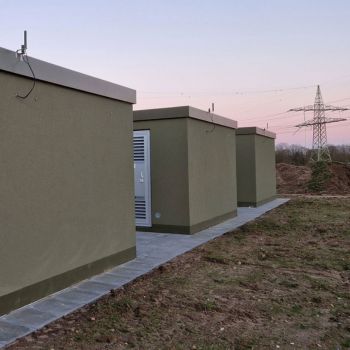450 MHz spectrum for utilities
450 MHz spectrum for critical communication
The 450 MHz spectrum is a low-frequency band ideal for critical long-range wireless communication. In many countries, utilities are adopting private LTE networks in the 450 MHz band to connect infrastructure where conventional networks fall short. The 450 MHz spectrum (often referred to as LTE 450) delivers extensive coverage over large remote areas, with high availability even in the most challenging environments, all within a secure private LTE network.
Westermo has the expertise and technology to support you every step of the way of your 450 MHz journey.

Compact 450 MHz Cellular Router (Band 31, 40 & 72)
The Merlin-3103 is a compact industrial cellular router, providing high speed data network connectivity for demanding industrial and smart grid applications. Operating in the 450 MHz spectrum for long-range, reliable coverage across wide areas.
Upgrade your network nowThe benefits of 450 MHz
for utilities

Extensive coverage
Many utilities have infrastructure spread out over large, remote areas. 450 MHz allows communication to take place across a larger area with fewer cell towers needed.

Access to the inaccessible
Low frequency allows for reliable communication even in challenging environments and hard-to-reach spots, since it can penetrate buildings and obstacles as well as avoid reflections.

Established solution
The 450 MHz spectrum is connected to an ecosystem of vendors, radio access network providers, and supported by standardizations such as 3GPP and organizations like the 450 Alliance.

Build private networks with secure, versatile and rugged 450 MHz routers
Explore the Merlin range450 MHz use case

Westermo is a member of the 450 MHz Alliance
In this interview with Gösta Kallner, the Executive Chairman of the 450 Alliance, shared his thoughts on the advantages of 450 MHz.
Read the interview with the 450 AllianceProud members of
Use cases in utility networks

Smart grid communication
Reliable data communication solutions for smart grid applications. Simple configuration and large-scale deployment.

Distributed Energy Resource
Cellular connectivity enables energy to be drawn on demand from multiple locations at once.

Remote water and waste water connectivity
View isolated and unmanned sites holistically with remote connectivity.

Protocol conversion
Protocol conversion enables one common stream of data to be transmitted or received to the top-end SCADA.

Effortless router management at scale
Activator software offers zero-touch deployment for quick and secure router setup, comprehensive remote management for large estates, and real-time monitoring to ensure optimal performance. Its scalability and enhanced security make it an invaluable tool for modern network management.

LTE 450 MHz antennas for private networks
For the reliable connection of digital secondary substations and utility applications, Welotec offers outdoor-suitable LTE 450 and combined LTE antennas with MIMO technology. These antennas are compatible with 4G LTE 450 MHz routers and other end devices and ensure stable connections even under challenging conditions.
Discover secure transmission
Master cellular communication
This Westermo Academy course delves into learning how to use the Merlin series. Configuration, troubleshooting, and how to achieve secure device deployment, all with a focus on remote access.
Frequently Asked Questions – 450 MHz Spectrum
A: The 450 MHz spectrum refers to a low-frequency range (around 450 MHz) that has been standardized for mobile communications and tailored to industrial and critical infrastructure use. It’s essentially the lowest-frequency band in the 4G/LTE domain that’s used for wireless broadband. Because of its propagation characteristics, 450 MHz is ideal for long-range, reliable communication – a single base station can cover a much larger area compared to higher-frequency cellular bands. This makes it very important for utilities (electricity, water, gas) and other critical sectors that need to connect widespread assets. Utilities are adopting private LTE networks in the 450 MHz band to get secure, dedicated wireless links for their infrastructure, separate from public cellular networks. In summary, 450 MHz offers utilities a way to build their own cellular network that provides broad coverage, strong signal penetration, and enhanced security, which is crucial for maintaining power grids, pipelines, and other remote systems.
A: A private LTE network at 450 MHz offers several key advantages for utilities and similar industries:
Extensive Coverage with Fewer Sites: The lower frequency signals travel far. A 450 MHz base station can cover a much larger geographic area than higher-frequency cell towers, which means a utility can blanket its service territory with relatively few masts/towers. This makes connectivity feasible and cost-effective even in remote rural areas, since long-distance links are possible and there are less “dead zones.”
Better Penetration and Reach: 450 MHz radio waves penetrate obstacles (buildings, dense foliage, hills) more effectively than higher frequencies. This is crucial for utilities that need signals to reach inside substation buildings, underground vaults, or across rugged terrain. The band’s ability to go through walls and cover challenging topographies means “hard-to-reach” assets can be reached reliably over wireless.
Reliability and Autonomy: With a private 450 MHz network, a utility isn’t sharing bandwidth with millions of public users. The network is dedicated to utility operations, so it remains stable even during peak public usage or emergencies. In fact, 450 MHz networks are seen as highly reliable for critical services – they can keep water pumps, grid controls, and other systems connected even if public networks fail. For example, even during major storms or power outages, a well-designed 450 MHz system can ensure that grid telemetry and controls remain operational or are restored quickly.
Control and Security: Because the utility owns (or exclusively operates) the network, it has full control over coverage and capacity. Utilities can implement their own redundancy, maintenance schedules, and security policies without depending on a public carrier’s priorities. This level of control and independence is a major benefit for critical infrastructure operators who require guaranteed communication links. (We cover security in more detail below, but in short, the dedicated nature of 450 MHz adds a layer of protection and reliability public networks can’t match.)
In summary, 450 MHz offers utilities a communications solution that covers vast service areas, reaches difficult locations, and delivers reliable, mission-critical connectivity with the utility in the driver’s seat. These benefits directly address common utility challenges like sparse infrastructure locations, harsh environments, and the need for always-on links.
A:The 450 MHz band is available in many countries across Europe, Asia, the Middle East, and elsewhere, but it’s not an open public band, it’s typically licensed for use by critical infrastructure sectors. National regulators often allocate 450 MHz to utility communications or public safety, sometimes via a designated 450 MHz operator or consortium. Globally, the use of this spectrum is coordinated and promoted by the 450 MHz Alliance, a non-profit industry organization comprising utilities, equipment manufacturers, and telecom operators.
Westermo is a member of this alliance, reflecting our active role in the 450 MHz ecosystem. In practice, only authorized entities (such as utility companies or specialized network operators serving them) can deploy networks in the 450 MHz band – this keeps the spectrum dedicated to critical communications and free from general consumer use. Because the band is protected and specifically allocated for critical infrastructure, 450 MHz networks don’t face the interference or unpredictability that plague public cellular frequencies. This regulated access ensures that utilities and other eligible users can count on a stable, interference-free wireless environment for their private LTE networks.
A: Not to the extent of mainstream consumer LTE/5G networks - and that’s by design. The 450 MHz band uses 4G LTE technology (and can support LTE-Advanced features), so it is fully modern, but its channel bandwidth is typically narrower and optimized for coverage rather than sheer throughput. In practical terms, a 450 MHz network will provide decent data rates suitable for industrial applications (such as SCADA data, meter readings, video surveillance, and telecontrol).
However, it won’t match the high peak speeds of, say, urban 5G networks or even LTE on higher bands. Utilities don’t usually need gigabit-per-second speeds for their use cases, they prioritize reliable, wide-area coverage and stable connections. The 450 MHz system delivers on that priority: it offers high reliability and availability rather than ultra-high bandwidth. In other words, it’s fast enough for critical telemetry and control data, but you wouldn’t use 450 MHz as a general-purpose mobile broadband network for thousands of smartphone users. This trade-off (coverage vs. bandwidth) is acceptable and even preferable in the utility context, where safe operation and constant coverage trump raw speed.
A: Very secure. A 450 MHz private network inherently provides a high level of security and resilience, for several reasons:
Isolated, Private Infrastructure: Unlike public carrier networks, a utility’s 450 MHz LTE network is typically a closed system. It operates on dedicated infrastructure, separate from the public internet and open networks. Only authorized personnel and devices can access it. This isolation dramatically reduces exposure to cyber threats – common internet attacks or random hacking attempts simply cannot reach a truly private network. It also means the utility isn’t affected by public network outages or congestion, which adds to security and reliability.
Licensed Spectrum Protection: The 450 MHz frequency is exclusively allocated to critical communications in each region, so no unauthorized users should be transmitting on it. There’s no interference from consumer devices. This protected status makes jamming or spoofing the network more difficult compared to unlicensed bands. In short, the airwaves used are clean and reserved, which is a security advantage (fewer chances for an attacker to even attempt to penetrate the wireless link). The 450 MHz Alliance and national regulators also ensure that the ecosystem remains focused on secure, utility-grade implementations.
LTE Security Features: 450 MHz networks employ standard LTE encryption and authentication. All data over the air is encrypted using robust 4G security algorithms (just like on your phone, but here it’s solely your devices on the networks. SIM cards (or eSIMs) and network credentials are used to prevent any rogue device from joining. This means the baseline of confidentiality and integrity of communications are strong. Additionally, because it is a private network, utilities can enforce additional security layers such as private APNs, firewall policies, and network segmentation tuned to their needs.
Additional Hardening: Utilities often implement extra measures on top of the inherent protections. For instance, they may (and should) run a VPN over the LTE link to ensure end to end encryption of the data passing through the WAN (wide area network). While a 450 MHz network is already separate and encrypted, such defense-in-depth (e.g., VPN tunnels, Firewall, strict authentication, intrusion detection systems) can be applied for maximum security. The network equipment itself (like Westermo’s routers) also comes with industrial-grade security features – for example, Trusted Platform Modules, secure boot, and regular security updates – further safeguarding the system.
In summary, a private 450 MHz network offers a controlled, closed environment with state-of-the-art wireless security. It is far less exposed than public networks. Of course, like any critical system, it must be managed properly (access controls, monitoring, and maintenance), but the fundamentals – dedicated spectrum, LTE encryption, and private ownership – give it a strong security foundation out of the gate.
A: Building a 450 MHz private network involves two sides: the radio access network (base stations, antennas, spectrum licenses) and the endpoint devices (routers/gateways in the field). Westermo specializes in the field devices and the management of those devices. Specifically, we provide the Westermo Merlin series of industrial cellular routers, which are fully compatible with 450 MHz LTE deployments. These routers are rugged, secure, and tailored for utilities – for example, they can be installed in remote substations to provide connectivity over the 450 MHz network. The Merlin routers support LTE Band 31 (450 MHz) and other bands as needed, ensuring that utilities can connect legacy and modern equipment over the private network. They also have built-in features like serial/Ethernet interfaces and protocol conversion, which allow them to link older SCADA devices into the new IP network seamlessly. This is crucial in substations where older protocols might still be used – the router acts as a bridge.
In addition to hardware, Westermo offers an advanced software platform called Activator for zero-touch deployment and management of our routers. Activator is a provisioning and monitoring tool that lets you configure thousands of remote routers automatically and keep them updated from a central location. This is very helpful for 450 MHz projects, because a utility might roll out hundreds or thousands of devices across their grid – with Activator, they can be set up with minimal on-site effort and monitored continuously, which saves time and ensures consistency.
When deploying a 450 MHz solution, Westermo often works alongside the 450 MHz network operator or the utility’s telecommunication team to deliver the complete package. While Westermo’s direct offerings are the routers and management software, we partner with others for things like the radio network itself or specialized 450 MHz antennas (for example, Welotec, which we aquired in 2025, provides high-performance LTE450 antennas). In summary, Westermo can supply the end-user devices and tools – the Merlin routers that go into the field and the systems to manage them – which together enable utilities to leverage the 450 MHz spectrum effectively for their private network needs.
A: Yes, 450 MHz private networks are already being rolled out by forward-thinking utilities. One prominent example is Energie AG in Austria. Energie AG is leveraging the 450 MHz band to upgrade and connect 6,000 substations across the Austrian Alps via a private LTE networ. This project was driven by the need to replace an aging CDMA system and to ensure a secure, long-term communication solution for the electric grid. The topology in their service area ranges from flat plains to high mountains, and they found that 450 MHz signals work reliably across all of these terrains. The superior propagation of 450 MHz means even remote mountain substations can communicate, and importantly, far fewer base stations are required in this project than would be with higher-frequency networks – which translates to a big cost savings and operational simplicity for the utility.
Westermo has been a key technology provider in the Energie AG deployment: about 8,000 Westermo cellular routers are being installed in the substations and other field location. These routers provide the secure links over 450 MHz and also handle local tasks like protocol conversion (integrating legacy equipment) and edge processing. Using our Activator software, Energie AG can remotely configure and monitor this large fleet of devices, which was highlighted as a “key to success” by their team. The private network grants Energie AG greater control over communications, with enhanced cybersecurity and “blackout-proof” operation, a critical factor for them, since ensuring connectivity during power outages was a major concern.
This Austrian project is one case study among several. Across Europe, numerous utilities and grid operators (in Germany, the Nordics, the Netherlands, etc.) are in various stages of deploying 450 MHz networks for smart grid connectivity, substation automation, and smart metering. The common theme is that 450 MHz provides a practical, reliable way to connect tens of thousands of devices spread over wide areas. Westermo’s involvement with Energie AG and others demonstrates that these networks are not just theoretical – they are being built now, and are delivering tangible benefits in operational efficiency and network resilience.
A: Absolutely. The 450 MHz band is fully part of the 3GPP global standards for LTE and 5G. In technical terms, 450 MHz LTE is often referred to as Band 31 (and Band 72 in some regions), and it is supported by major telecom equipment manufacturers as a legitimate LTE frequency band. This means that the technology used in 450 MHz networks is not a proprietary or niche solution – it’s built on the same LTE protocols and encryption algorithms that run the world’s mobile networks, simply tuned to a different frequency. There is a healthy and growing ecosystem of devices (routers, modules, smartphones, IoT sensors) and infrastructure vendors that support 450 MHz, thanks to its inclusion in the standards.
The longevity of 450 MHz as a solution is also well-supported. Utilities require long investment cycles, and the industry recognizes that: networks using 450 MHz LTE are expected to be available and supported for at least 10–15+ years going forward. In many countries, licenses for 450 MHz spectrum have been granted into the 2030s specifically for utility use. Furthermore, the 450 MHz Alliance (the industry group) is actively ensuring that this band stays relevant; they work on international spectrum harmonization and future technology upgrades. In short, the ecosystem is committed to making 450 MHz a long-term solution for critical communications.
Westermo’s commitment is likewise long-term: we design our 450 MHz-capable products to have a long service life (often a decade or more) and we plan to support utilities as their needs grow on this band. With strong standards backing and a coalition of industry players behind it, 450 MHz can be considered future-proof from both a technology and an availability standpoint. It provides a stable, standardized platform that utilities can invest in today with confidence that it will serve them for many years to come.
Nuri Shakeer
International sales

Behöver du teknisk hjälp? Klicka här för att kontakta vår support
